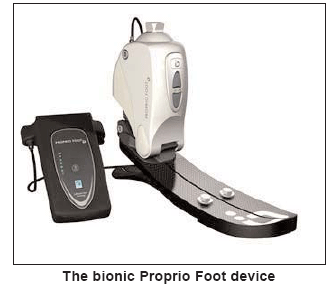A bionic foot that replicates a natural human walking gait has, to date, been used primarily for members of the military. Further refined and now available to the general public, the Proprio Foot is likely to change the prosthetic landscape.
"It's the technology of the future," said prosthetist Joe Reda, CPO, who is among the first technicians in the U.S. to be certified in the fitting of this device. "One of my first patients, a motorcycle rider, wore it on his bike to Sturgis Motorcycle Rally this week."
Reda is an assistant director at Kessler Institute for Rehabilitation (West Orange, New Jersey), one of the first rehabilitation centers in the country to offer the Proprio Foot developed by Ossur (Reykjavik, Iceland).
"It's the only computerized foot on the market," Reda told Medical Device Daily. "The biggest limiting factor is the cost right now and reimbursement."
With a price tag of $34,000, it's a bigger commitment than other foot prosthetics, which range in price from $5,000 to $18,000.
The artificially intelligent prosthesis for transtibial amputees operates like natural, anatomical functioning. Developed by Ossur's R&D department, the foot's motion analysis capabilities are facilitated by real-time sensor technology from Dynastream Innovations (Cochrane, Alberta).
The foot's name is derived from its ability to detect where the foot is in space, known as proprioception.
"It's got tilt sensors," Reda said. "It analyzes what the patient is doing and picks the toe up to allow the foot to clear the ground easier. Going up an incline, an amputee would generally walk on his toes and then down an incline on the heels because a regular prosthetic foot doesn't have the flexibility. With the Proprio, after the second step it flexes the foot going up, so the patient does a natural heel-to-toe gait. On the decline it does the same thing. When amputees go from sitting to standing, they usually use their good leg only, but with this foot, it flexes more so they can use both feet."
The Proprio includes sensor technology that mimics the body's own neural receptors that are sensitive to mechanical change, providing artificial proprioception – the sense of where the limb is in space, according to Ossur. The artificial intelligence (AI) processes information from those sensors and activates the most appropriate response for the next step. The AI transmits an ongoing stream of signals that instruct precise actuator technology to act and deliver optimal function.
It works unlike any other prosthetic limb Reda has ever used. But it lacks any cosmetic attributes.
"It's not a cosmetic leg by any stretch of the imagination. It's fairly bulky," said Reda, who is not affiliated with Ossur. "The ankle weighs 2 to 2.5 pounds with a large battery pack located on back of the socket. You can't cover it. But the function of the foot outweighs the cosmetic aspect."
Designed for below-the-knee amputees, Proprio requires some basic programming when fitted with a patient that takes about 45 minutes. The battery stays charged for 36 hours before recharging is required.
"The technology is there," Reda said. "I'd like to see a smaller battery and unit."
He added that while the foot is not intended for athletic use such as running, it is designed for active people.
Until now, the Department of Defense and the U.S. Department of Veterans Administration have actively used the foot to benefit service men and women returning from the Iraq and Afghanistan conflicts, as well as veterans of past wars, according to Ossur.
The company is currently working to obtain Medicare reimbursement coding.


